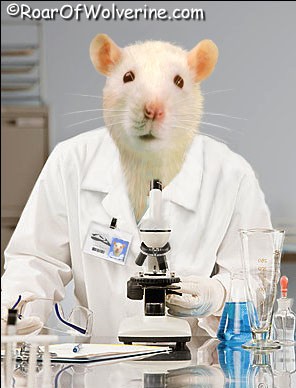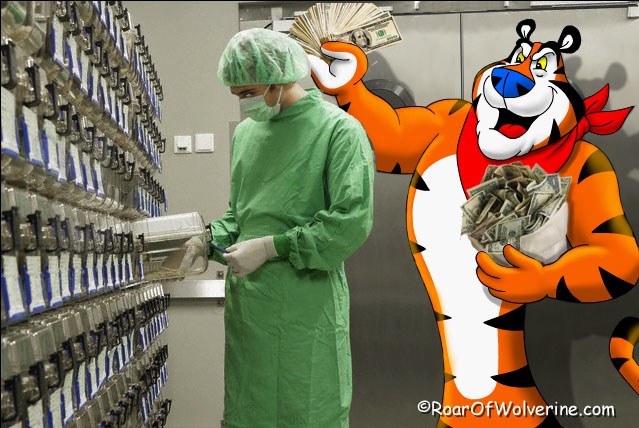I Smell A Rat
 Every time a story breaks the headlines claiming that the results of some research has indicated that red meat or saturated fat is linked to cancer, heart disease, diabetes, hemorrhoids, global warming, the war in the Middle East, murder, mayhem and mass genocide, you can bet your ass that 99% of the time the volunteers were buck-toothed little rats. Are rats that similar to humans and are they a reliable analog for the effects of our food on our body?
Every time a story breaks the headlines claiming that the results of some research has indicated that red meat or saturated fat is linked to cancer, heart disease, diabetes, hemorrhoids, global warming, the war in the Middle East, murder, mayhem and mass genocide, you can bet your ass that 99% of the time the volunteers were buck-toothed little rats. Are rats that similar to humans and are they a reliable analog for the effects of our food on our body?
Metabolically speaking, rats are very similar to human beings and many tests using them as subjects can be quite valuable. My concerns have less to do with drug testing and more to do with dietary effects. When looking at a rat study, I always take into consideration the digestive and dietary variance between humans and rodents, and how easily these experiments can be manipulated based on those differences. Assuming that most research is rarely unbiased, can the experiment be constructed to achieve a desired result?
How are Mickey and Minnie different from humans? Though nobody likes to vomit, it is often a life-saving technique evolved to rid the body of undesirable toxins, pathogens or just overindulgence. Unfortunately for the rat, they lack that ability for three reasons:
-
Rats have a powerful barrier between the stomach and the esophagus. They don’t have the esophageal muscle strength to overcome and open this barrier by force, which is necessary for vomiting.
-
Vomiting requires that the two muscles of the diaphragm contract independently, but rats give no evidence of being able to dissociate the activity of these two muscles.
-
Rats don’t have the complex neural connections within the brain stem and between brain stem and viscera that coordinate the many muscles involved in vomiting.
A study of food can be easily manipulated by feeding a rat an amount of food that a human would typically throw up. Feeding high quantities of a particular nutrient, even essential ones, can cause serious and even deadly results. This is no basis for vilifying a nutrient. An example would be iron. People who suffer from a gene mutation called, “Hemochromatosis” absorb iron at much higher levels than normal. The human body has no mechanism to get rid of excess iron, so it begins to store the iron surplus in the joints and organs . This “iron overload” ultimately leads to crippling arthritis, heart damage and cirrhosis of the liver.
I could easily feed excessive iron to a rat and show definitive results that iron is a deadly nutrient. We all know that a small amount of iron is not only healthy, but essential. Without iron, we cannot make blood cells and become anemic (a life threatening condition). This same principle is true with nearly every nutrient. Sodium, potassium, zinc, copper, calcium are all essential for good health, yet are deadly in high concentrations. So the first question is how much red meat or fat was force-fed to the stinking rats?
If you think they are wining and dining these varmints on prime rib, you’re sadly mistaken. Every study I have read used highly processed meats in their experiments. That is fine if your final conclusion is going to read that bologna is linked to colon cancer, but that is never what they report. It will always proclaim that it was red meat that caused the problem. The equivalent to the type of “meat” used in these research experiments are more similar to Spam than steak. So the conclusion should read, “If you are eating Vienna Sausages for breakfast, lunch and dinner everyday, you may develop colon cancer”. How many other compounds and chemicals are used in the processing of hot dogs, cold cuts or potted meats? Maybe it’s the nitrates, nitrites, sulfur dioxide, monosodium glutamate, salts, sugar, cereal fillers or hydrogenated oils used in this embalming that triggered the disease. But the final report will always single out the meat or saturated fat.
What about the fat? This is the second piece of chicanery perpetrated by rat researchers. Do you really believe they are slicing the fat from a nice T-bone for the rats? Think again. More often than not, when lard or coconut oil are used in rat experiments, they have historically been hydrogenated, creating a trans fat. Trans fats have been proven to lower HDLs and raise LDLs. Seed oils are liquid at room temperature and are hydrogenated to simulate saturated oils and make them solid. Unlike seed oils, coconut oil and lard are naturally saturated and solid at room temperature. There is no advantage to hydrogenate them, except to achieve a negative result. So, the next time you hear that researchers have linked saturated fat and heart disease, remember that the rats were most likely fed the equivalent of Crisco.
Studies on dietary fat have other problems, namely the fact that rats have no gall bladder. Rats do produce bile from the liver, but the absence of a gall bladder would suggest that they didn’t evolve on a high fat diet. Herbivores and omnivores that exist on mostly plant dominated diets, have either no gall bladder or very tiny ones. Meat-eating animals all have highly developed gall bladders to handle the load of fat in their diet. This fact alone makes any study on the effects of animal fat on rats irrelevant as far as I’m concerned. This explains why rats refuse to eat lard or other fats in these research experiments. In order for the researchers to get the rats to eat high quantities of fat, they have to mix it with sucrose. How are we to determine if the negative effects are from the fat or the sugar? Just another deception.
Another favorite slight-of-hand by rat researchers is the isolation of animal proteins such as casein, and force feeding huge quantities to the test subjects. Any isolated protein can be toxic. People who consume protein in the absence of fat or carbohydrates suffer from “rabbit starvation”, a life threatening illness. I could certainly kill a lot of rats if I fed them isolated gluten from wheat, but we never see researchers test that one, because the target is always animal products. Salt is a necessary nutrient, but isolating it and jamming large quantities down any animal’s throat would result in their extermination, but wouldn’t prove that we should remove salt from our diet.
Rodents are one of the few mammals that seem to do well eating grains. All livestock mammals become sick when fed grains and need antibiotics. There is mounting evidence that humans are more like the majority of mammals and become sick on grains, thereby making rodents a poor analog for humans in these experiments. It is my belief that you could target any particular food and adulterate it, feed it to rats in massive quantities and make the them sick. This is why it is so easy to poison rats. They are extreme opportunist and will eat just about anything. If what they consume is poisonous, they are unable to throw it up to reduce the amount of poison that will enter their bloodstream.
I think that most people believe that an equivalent amount of studies are conducted on the effects of other foods, such as grains, vegetable oils, or high amounts of sugar. This is simply not true. Animal products are far less profitable than grain commodities and processed oils, so it is much easier to get funded for any study that will further denigrate animal foods. Laboratory research cost money and must be funded by someone with deep pockets. Many times they are funded by corporations on their own products. I certainly see no conflict of interest there.
Many other studies are funded by government agencies. The USDA is committed to the marketing of grains. The more people are frightened about animal products, the more they will replace them with cereal-based foods. Gary Taubes, science writer for the New York Times wrote in his book, “Good Calories, Bad Calories”:
Scientists were believed to be free of conflicts if their only source of funding was a federal agency, but all nutritionists knew that if their research failed to support the government position on a particular subject, the funding would go instead to someone whose research did.”
There is an obvious bias, as a rule, in the majority of the research community. The customer is always right, and in this case, the customer is whoever is granting the funds. This is true in any occupation. I have worked in the commercial arts. I have had clients instruct me to do the most distasteful and hideous things to sculptures, but if I want to get paid, I did as they wanted. Oftentimes, I am embarrassed by the results and would not add the work to my portfolio, but I happily spent the money. So I can easily imagine that researchers also have mortgages to pay and mouths to feed.
In conclusion, I am always skeptical of any dietary study performed on rodents because they can be force-fed, can’t vomit, are naturally herbivores, but more so because they can’t tattle. Though they may squeak, they can’t squeal… on their researchers, that is. We’re never going to read a rat’s manifesto of their treatment as a research subject. This leaves us to rely on the integrity of the researcher, or more accurately, whoever is funding the study. I am way too cynical for that. So when I read a headline touting a study not involving human subjects specifically, I always smell a rat.
